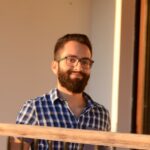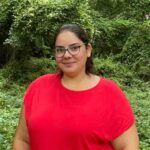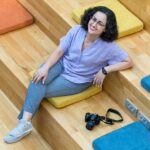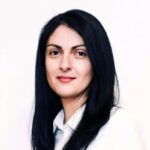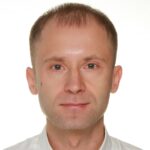The eAkrounta project has definitely been a great lifetime opportunity. It was a wonderful journey from starting point to conclusion. This experience was enriched with extraordinary moments and work ethic, including the research into the community’s history, interviewing people and reflecting the results on the newly-created website. Bringing the past to the present was the most incredible part of this journey. I am very proud and glad, mostly because I was a part of this mosaic of people who worked together to bring this project to life.
The eAkrounta project digitally showcases Akrounta’s history and culture. It features a digital archive, a website and a documentary based on interviews with the people of the village. Landmarks in the village have special QR-coded signs for more online info. Volunteers of all ages, from various fields, collaborated on this community-driven initiative, which highlighted the power of collective effort and digital tools.
Participation means being active in the area you live in. Don’t just sit back and criticise. Be proactive, take the initiative and even if you make mistakes, learn from them. In conclusion, participation is about giving back and contributing positively to your community.
Charalambos Christoforou, a core member of the eAkrounta project, shares his insights on the project’s inception and development.
Can you introduce yourself and explain how you first identified the need for this project?
I’m affiliated with the local youth club in the village of Akrounta in Limassol, Cyprus. Over the years, our team noticed a lack of comprehensive resources for tourists and even locals about our village.
Our main motivation arose from the difficulty in finding information, particularly about our old village church. We wanted to compile both old and new photos of this historical site, research its history and promote other lesser-known village attractions. The overarching goal was to showcase what our village offers, which many might not be aware of.
What happened next?
Our observations led us to create a website to consolidate the village’s whole history, including old photographs that needed preservation.
As we progressed, we also identified the opportunity to create a documentary movie. We interviewed individuals from different age groups, specifically those in their 60s, 70s and 80s, in order to capture diverse perspectives on the village’s evolution. Our primary goal was to keep these cherished memories alive.
How did the project get connected to the youth club?
The youth club has been active in our village for 40 years. It began as a football team but has since expanded its role and organises various events throughout the year.
As we approached the youth club’s 40th anniversary, we felt the eAkrounta project would be a fitting gift to the village. While the project was led by club members, it received support from friends and the wider community. Many who contributed to the project even joined the club, making it a collective village initiative.
When you approached the village’s elders and community about your project, what was their response?
We spoke to several individuals, who were chosen based on their age and roles in the village. They were eager to share their memories and show their strong connection to the village. They were accommodating, even setting up convenient times for interviews. We also asked the community for old photos. While not many came forward, those who had photos shared them. Overall, the community responded positively, and the Community Council was supportive whenever we needed them.
What form did the teamwork take in the eAkrounta project?
From the beginning, our main team was very positive about the idea. We all volunteered our time, and while we had some challenges, the project was interesting, so everyone enjoyed working on it.
All our volunteers were under 35, with our youngest being just 10. It’s a challenge because not every young person in the village shows interest. Typically, a core group of about 10 people handles most tasks. While we sometimes see more participation in certain activities, it’s this core group that’s consistently active. But this certainly has its perks; we’ve become a close team and collaborate efficiently.
We got help from outside too. Some people provided interviews, while others gave us old photographs. We took these photos, scanned them and made them digital.
For parts of the project that we couldn’t do ourselves, like taking pictures from high up in the sky or editing videos, we asked professionals to help us. There were also people who didn’t live in the village but had a connection to it, and they helped us too.
The involvement of a 10-year-old is intriguing. What was his role?
He offered a fresh perspective, suggesting ideas for our questionnaire. He assisted in setting up interview locations, contributed questions and even collected stories from his grandfather about the village. He was hands-on wherever he could be. We see him playing a more significant role in our team’s future.
Were there any memorable moments or challenges during the project’s various activities?
Conducting interviews was especially fascinating for me, given my interest in documentaries. I had to pick up skills in videography and sound engineering. We also took photography lessons to better capture the village’s essence.
We learned to digitise photos and, while we didn’t build the website, we conveyed our vision to professionals who did. The same went for drone photography; we scouted locations and then combined our footage with the professionals for editing. Engaging with different experts was a big part of our journey.
Can you give any examples about sharing interesting tales of village traditions?
Among others, we interviewed Mrs. Eleni who is my aunt and one of the older residents of the village. She shared stories about village weddings where the entire village would prepare food for the guests. It was a time of cooperation. She spoke about village games, where everyone participated and shared food. She recounted her life as a shepherd and their day-to-day activities. It was fascinating to hear about the village’s past through her experiences.
After implementing this project, what changed for the village and its community?
The implementation of eAkrounta brought significant benefits both to the community and to the young people who participated in its execution. On the one hand, the community of Akrounta gained a digital archive that showcases its history, culture and environment. Simultaneously, it was modernised by establishing its digital presence on the web and innovated by marking points of interest and utilising QR codes at these locations. Furthermore, the number of people who know about the community has increased and visitors now have the opportunity to learn about where they are with a simple click on their mobile phone, thus helping to increase tourism.
On an individual level, the older residents were reminded of the old times, which gave them a sense of pride. Some of the newer residents approached us, surprised at some of the findings. They’d say, ‘I didn’t know that existed’. All in all, the people in the village became closer during the project.
Even people outside the village learned new things about it. We gathered a lot of interesting historical details, especially from Mr Giorgos, who has conducted extensive research on the village. For instance, there’s an old church believed to be around 500 years old. When I was young, it was mostly in ruins, but archaeologists restored it based on their findings.
If another village wanted to start a similar heritage project, what advice would you give based on your experience?
First, be prepared to invest a lot of your time. These projects might sound straightforward, but they require significant effort. My primary advice is to start small. For instance, we began by focusing on a few points of interest in our village, around six or seven, without diving deep into the full history. From there, you can expand. So, prioritise time management and take small steps initially rather than trying to do everything at once.
Project outcomes
Some visual materials from the eAkrounta project are available on its website. These include a trailer for a documentary and a photo archive that showcases the history, modern life, and sightseeing opportunities in Akrounta village.
A trailer for a documentary
A photo archive
About the project
Supported by:
European Solidarity Corps
EU Youth Programme Priority:
Digital Transformation
Topic:
Youth Participation / Skills Development and Volunteering
Digital Participation
Youth Goals:
Visibility:
Social media was utilised to promote the activities of the eAkrounta project. During the Youth Club’s 40-year celebration, a trailer of their documentary was screened and a photo gallery displaying both old and new photos was hosted, which attracted significant attention to the programme.
Upon completion of the documentary, a screening event was organised for the village residents, where the eAkrounta.org website was also introduced.
After the project’s completion, it gained recognition from various sources. Local television channels covered the project, and it was presented to visitors in Cyprus for Erasmus+ programmes who reached out. The project was also recognised as one of the top three finalists in the Digital Transformation category at the Salto Awards 2022.
Organisations involved:





